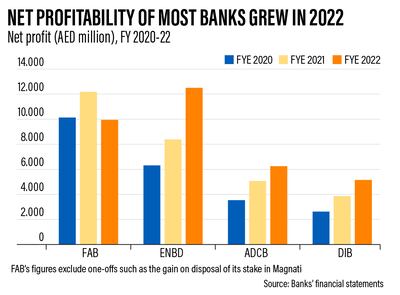The combined net profit of the UAE’s 10 largest banks rose by 35 per cent on a quarterly basis in the first three months of the year due to enhanced cost efficiencies and lower impairment charges, professional services consultancy Alvarez & Marsal has said.
The aggregate net income for the three months to the end of March climbed to Dh18.3 billion ($5 billion), the consultancy said in its UAE Banking Pulse report on Monday.
The profitability of the country's top lenders was also boosted by a rise in non-core income, which increased by 12.5 per cent on a quarterly basis, the report said.
Total net interest income, which is what lenders earn from their lending activities minus the interest they pay to depositors, increased marginally by 0.4 per cent on a quarterly basis.
Overall net interest margins (NIMs) remained stable at 2.8 per cent for the January to March period, the report said.
Net interest margin is a measure of how successful a lender’s investment decisions are, compared with their debt situations.
“This has been a very strong quarter for the UAE banks. We expect that for the balance of the year, the UAE banking sector will maintain the gains of the first quarter,” said Asad Ahmed, Alvarez & Marsal managing director and head of Middle East Financial Services.
“Stable NIMs, improving cost efficiencies and lower impairments have led to record profits for the UAE banks in the current quarter, although we witnessed mixed performance by some banks on the margin front.”
The UAE’s economy has rebounded strongly from the coronavirus-induced slowdown on the back of government initiatives, higher oil prices, a strong performance in its property sector and a sharp rise in travel and tourism.
After growing by 7.6 per cent last year, the highest in 11 years, the UAE economy is expected to expand by 3.9 per cent this year and 4.3 per cent in 2024, the UAE Central Bank said in March.
The country’s economy is expected to grow 2.8 per cent in 2023, according to the World Bank.
Lenders in the Arab world’s second-largest economy, as well as in the GCC, where most central banks peg their currency to the US dollar, are also benefitting from rising interest rates as their economies recover and inflation in the region remains relatively low.
The US Federal Reserve earlier this month increased the interest rate for a third consecutive time this year, by 25 basis points, to tame inflation and restore price stability.
The central banks of the UAE, Saudi Arabia, Bahrain, Qatar and Oman also raised their benchmark borrowing rates after the Fed's move.
“A modest reduction in economic growth is expected on the back of the agreed oil output cuts and higher interest rates. Higher margins should drive bank profitability, though slightly tempered by an uptick in provisioning – the latter tends to accompany a rate increase,” said Mr Ahmed.
In a surprise move last month, Opec+ members – including Saudi Arabia, the UAE, Iraq, Kuwait, Oman and Algeria – announced voluntary oil production cuts amounting to 1.16 million barrels per day from May until the end of the year as a precautionary measure to support oil market stability.

The cumulative loans and advances (L&A) of the UAE’s top banks increased by 2 per cent in the first quarter of this year over the same period last year, while deposits were up 6.2 per cent on a quarterly basis, A&M said.
Incremental deposit growth outstripped credit growth for the first time in the first quarter this year since the first quarter of 2022 amid monetary tightening, the consultancy said.
Customer deposit mobilisation outpaced the growth in loans and advances – the highest in the past four quarters, at 43.5 per cent in the first three months of the year, it said.
The UAE’s 10 largest listed banks covered in A&M’s survey are First Abu Dhabi Bank, Emirates NBD, Abu Dhabi Commercial Bank, Dubai Islamic Bank, Mashreq Bank, Abu Dhabi Islamic Bank, Commercial Bank of Dubai, National Bank of Fujairah, National Bank of Ras Al Khaimah and Sharjah Islamic Bank.
“The UAE banks are well provided for and sufficiently capitalised to maintain capital adequacy ratio levels well above regulatory requirements,” said Mr Ahmed.







